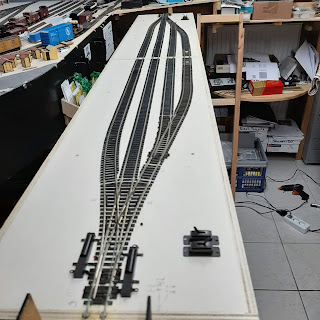The OTM (On Track Maintenance) tracker is manufactured by Brandt in Canada.

(Photos for reference only)
Although they use John Deere components for their MOW equipments, I started with a Kibri Liebherr Excavator model.
The OTM tracker can move on top of railway gondolas and deliver track ties, ballast and rail along the railroad track, where needed. It is quickly transitioned from the highway transport deck to the top of rail maintenance cars within minutes.
Actually there is only one H0 model available, but it proves to be too expensive to ship over to Europe. So I decided to scratch build a more or less believeable representation of such a piece of equipment.
As with every scratchbuilding project, it all starts with a handful of styrene strip and profiles from Evergreen.
First, I started with the moveable frame.
I cut two pieces of #284 H-column, nine feet long, and five pieces of #175 five feet long. I then glued the five .100x.100 square strips between both H-columns, spaced like in the picture below.
Then I cut two strips of #145 to fit diagonally between the center and the outside braces. I sanded and beveled the strip, until they fit correctly. (see picture below)
Next, I modeled the ends of the frame with the hydraulic pistons (simplified)
I need two pieces each of #266 channel and #138 square strip, cut to seven feet length. One square piece is glued to the back of one channel piece. Then I cut four #223 tube two feet long. These are the pistons and glued to the outside edges of the channel assembly. (picture below)
Then I glued the piston assembly to the edge of the frame, like in the above picture with the completed frame.
The next sub-assembly is the moveable pads, which rest on the rim of the gondola.
I cut two #252 square tube pieces 8.5' long (they should loosely fit between the gondola walls).
Then I cut four #153 square strip pieces four feet long and also four #133 strips, one foot long. The small strips are glued to the edge of the square strip, to form the pad.

Unfortunately the pads fit very loosely into the tube, so I carved the shaft with my hobby knife, to give them more friction inside the tube. Care must be taken not to cut or brake the shaft. I know it's not the most elegant solution, but it works. Probably after painting the shafts, there will be some friction also.
Then the pad assembly is glued to the bottom of the frame, like in the picture below. I added round styrene strip for the pistons. I have a sample pack from Slaters, so I don't know the exact size, but 1/32" should fit.The frame assembly should look like pictured below.Now on to the lower frame of the tracker platform.
We need two #252 square tube pieces again, and four each #153 and #133 of the same dimensions than for the large frame.
The two #284 H-column pieces are 7 feet in length. They are spaced with two #155 strips of 6.5 feet length. The two pad assemblies are glued to the edges of the #155 strips.
Two #133 strips are glued crosswise to the square assembly. It will look like on the picture below.
The lower platform and the large frame will look like in the following photo, with the large frame resting on the lower platform. They should barely touch.
As I mentioned above, I did use a Kibri kit #11264 instead of the prototype John Deere Excavator.For the upper platform, to which excavator is mounted to, I used the chassis from the kit and assembled the part following the instructions. It's only a two-part assembly. The axle suspension will hold the hydraulic pistons. To do this, I cut the lugs, which usually hold the axles, and sanded the underside flat, like seen on the picture below.
Then I glued the two assemblies to the axle mounts on the chassis, like seen in the picture below.
The length of the 'pistons' should be at least match the thickness of the large frame H-columns.
The upper chassis and the lower platform are now glued together with the large frame sandwiched in between. The large frame should move freely between the chassis assembly. Styrene rod is inserted into the round tubes to simulate the pistons.
Now the assembly is ready for the paint booth.
My OTM tracker painted and weathered.
A nice piece of equipment added to my modern fleet.
Next up will be another OTM tracker with a Caterpillar Excavator.
Stay tuned and thank you for your interest. Comments always welcome.
























































